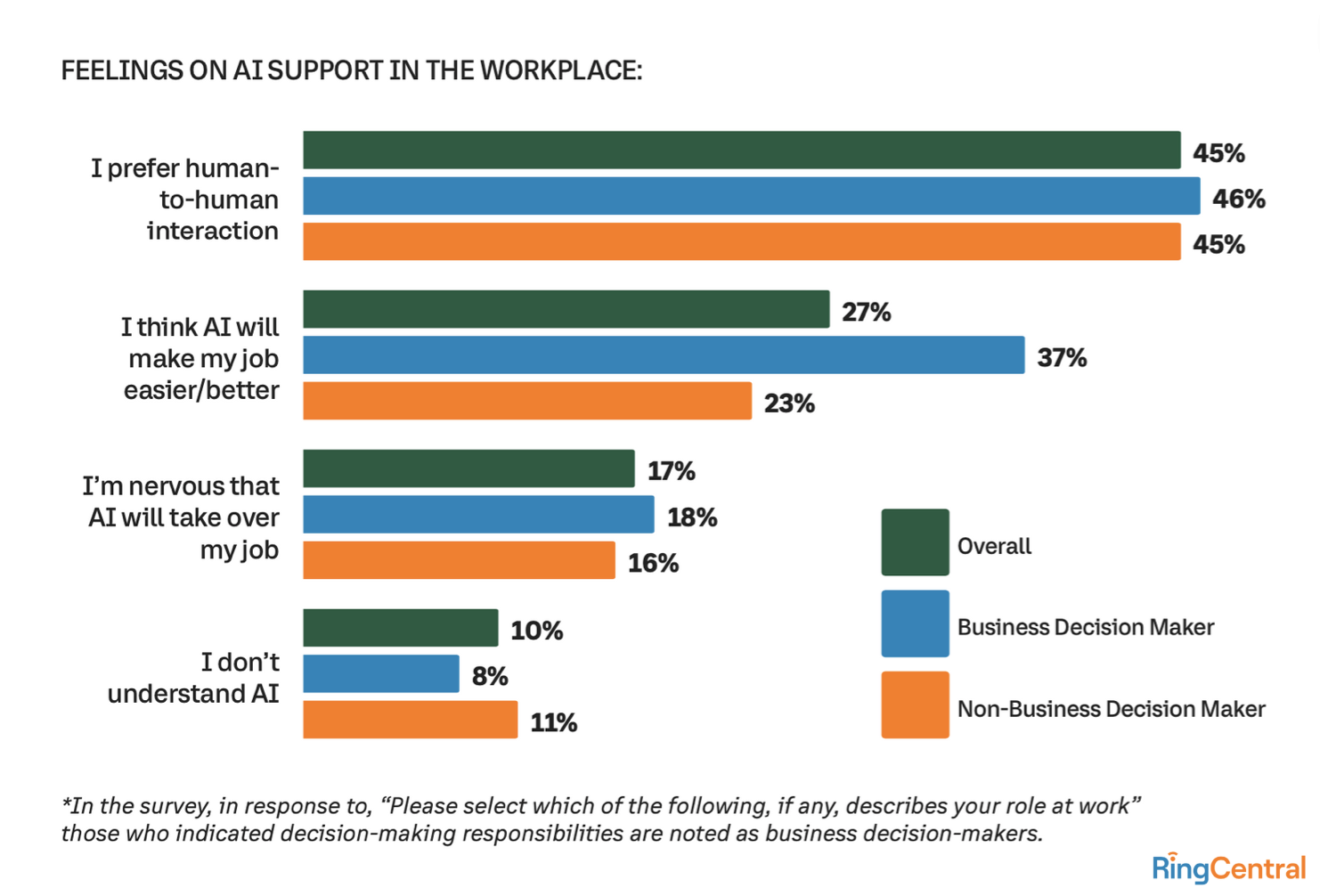If you have to ask that question, then yes, AI is moving too fast. Nobody is asking whether AI is moving fast enough, and in 2023, it’s certainly not behind the times. If anything, the times are now trying to catch up with AI, as its recent evolution has happened faster than our ability to adapt. There’s a growing chorus to set guardrails in place before our dystopian fears are realized, and it’s not just coming from casual enthusiasts.
While these concerns are absolutely valid, there is no shortage of practical use cases, including in the workplace, where AI is being widely touted to help automate workflows, and help workers better harness all the information that constantly crosses our paths. That said, deployments are very much in the early stage, and AI is still long on promise and short on tangible results.
However, with AI evolution being so fast-paced, there’s a real sense of FOMO – Fear of Missing Out – among business leaders. Given the challenges they face to stay ahead of the competition, create better workflows, and improve customer experiences, even small advantages can go a long way toward attracting, engaging, and motivating workers. There’s too much at stake to take a wait-and-see approach with AI. As such, AI is coming to the workplace whether we like it or not, but the implications are not fully understood.
There is always risk when adopting new technology, but AI is poised to profoundly change every aspect of work, so business leaders need to be especially mindful here. To support that, many studies are being done, and I’ve had a sneak peek at one that has just been published. This study was conducted by Ipsos, with most participants being US-based, but the sample also covers the UK, Australia, France and Germany.
Titled, “Navigating the AI Revolution: Workforce Perceptions and Opportunities,” various levels of full-time workers were surveyed, mainly about attitudes and expectations around AI. The research was commissioned by RingCentral, and while I’ve only had access to select data points, some key themes are clear, and quite timely, given how we’re all struggling to gauge how far and fast we should be taking things with AI.
Theme 1: Sentiment toward AI
The chart below reflects some fundamental issues about whether AI will replace, displace, or augment our work. We are all struggling to figure out what AI actually represents, and what the beneficial applications will be. That said, the definition of “beneficial” is highly relative, depending on factors such as your job function and age.
One of the key segmentation variables in this study is job function, split by “decision maker” and “non-decision maker.” Based on these designations, there are some notable points of difference, but also some sentiments common to both groups.
- In terms of how AI is viewed in the workplace, the main difference between these job functions is about making your job easier. Decision makers held a clear edge here over non-decision makers, with 37% feeling this way about AI making their job easier, compared to 23% for non-decision makers. This implies that decision makers have higher expectations about how it will benefit them. That’s good news – for them – but non-decision makers don’t have such a rosy view. While it’s early days with AI, business leaders need to think about managing expectations, as not everyone will benefit in the same way.
- Low levels of understanding about AI. To some extent, the gap outlined above is mirrored in the last variable in the chart below. Before addressing that, it should be noted that only 10% overall said they don’t understand AI. The important takeaway is how there’s a lower level of understanding among non-decision makers compared to decision makers – 11% vs. 8%. Again, business leaders need to take this into account, and make extra effort to help non-decision makers better understand AI. (Not having access to the full data set, I can’t infer the converse – that 90% do understand AI – that’s just not a reasonable assumption given the complexity of AI.)
Now to consider common ground for these two groups, the two other variables tell a different story in terms of attitudes and concerns about AI.
- Strong preference for human-based interaction over AI. For this variable, the data shows 45% of the total sample feeling this way. Again, without the full data set, only limited conclusions can be drawn, but it’s clear that both decision makers and non-decision makers feel the same way. As such, nobody is looking for AI to become the main form of interaction – at least for the time being. For business leaders, this sends a strong message to take a measured approach with AI in terms of its potential to displace workers.
- Concerns about AI taking their jobs. This is the third variable in the chart below, where concerns about AI taking their job are the same across the board. In absolute terms, the levels may be low, but are highly similar for both decision makers and non-decision makers. Given how quickly AI is evolving, business leaders should not conclude that these low levels of anxiety are a green light to ramp up deployment. For many businesses, 2023 is the year AI became a must-have, and depending how things unfold, these anxiety levels could well be much higher next year.
Theme 2: Expectations around AI
This was addressed in a variety of ways in the research, and here are the leading examples.
Will AI be important in your industry in 2023?
By job function, 44% of decision makers agreed, but only 26% of non-decision makers felt this way. The research didn’t address what these perceptions are based on, but expectations about AI’s importance seem higher for decision makers. Whether or not they have any special insights that others do not have, the implication is that non-decision makers may not yet recognize AI’s potential, so an understanding of that needs to be part of how AI is brought into the workplace.
How enthusiastic are you about integrating AI with your work processes?
The data for this factor was broken out by age, and a pattern emerged that seems reasonable to expect. While the interest level overall was relatively tepid, enthusiasm was clearly higher among younger workers. This is another indication that AI deployments will not be adopted evenly across the workforce, and business leaders may want to consider using some younger workers as mentors or ambassadors to help older workers adopt AI.
| Age Group |
Percentage "Enthusiastic" about AI |
| 21-34 |
37% |
| 35-44 |
30% |
| 45-54 |
17% |
| 55-64 |
9% |
How well do you understand how AI will be used in your workplace?
This reflects more about how an organization communicates its AI plans with employees than how well workers understand the applications. While many now have some level of understanding about AI in general, the understanding level is clearly lower in terms of specific applications within your organization.
Consider the levels reported by job function, where 21% of decision makers were “unsure,” but that level jumps to 41% for non-decision makers. The data doesn’t indicate if this means that decision makers have received advance briefs from management that non-decision makers didn’t get, but the gap in perceptions is real. If business leaders want to see across-the-board adoption of AI, they will need to do a better job explaining what they have in mind.
Theme 3 – Deployment considerations for AI
To date, workplace deployments of AI have been on a limited scale, so the track record is short. However, among those having done so, the results to date have been good, but not great. Overall, 43% had mixed feelings about the work produced with AI (oversight still needed), and 41% felt good about it (minimal edits needed on the work).
This is consistent with the chart from Theme 1, where human interaction is still preferred, and workers are far from ready for AI to take the lead on managing things. While it seems clear that AI is in the plans, workers will be cautious going down this path.
Workers know changes are coming, but nobody can really say what form that will take. Consider these two data sets:
- 33% feel that AI will replace many roles over the next 20 years
- In terms of having digital assistants in the next 20 years, 39% of decision makers agreed, and 31% of non-decision makers felt the same way
To be fair, with a 20-year time horizon, AI will likely be able to do anything humans can imagine, so these actually are very safe questions. For these particular topics, AI’s impact will likely be felt far sooner, probably within only two years, not 20. As such, the data is almost certainly understating AI’s impact, but at least there’s a sense here that workers are aware of what’s coming.
Conclusion
Even with this limited set of data, there are both promising signs here for AI in the workplace, but also points of caution. Technology will certainly be central to the success of AI in the workplace, but the onus to deliver value to the organization falls squarely on business leaders to recognize that not all workers will embrace AI the same way, and that expectations around your AI strategy must be clearly communicated and understood.
There is little doubt that the workplace is becoming more data-centric, and workers are becoming more digital-centric. These shifts are fairly new, and legacy technologies are ill-equipped to support them, not to mention supporting a distributed workforce with the hybrid work model. Add to that the exponential growth of data being generated from these new technologies, and all roads lead to AI as the enabler for a productive workplace.
That said, AI alone is not a silver bullet, and it’s evolving in ways we really don’t understand. While business leaders may see the value in AI for driving automation and reducing costs, it can do so much more, but only if adopted in ways that your workforce is actually capable of handling – and receptive to using. These findings from the Ipsos research provide a good foundation for business leaders to follow, and as more highlights become available, I hope you’ll explore them as well.










